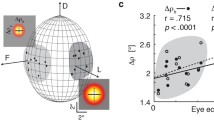Summary
-
1.
The temporal resolution of colour vision was measured in freely-flying honeybees by testing the performance of trained bees in discriminating between two stimuli, one of which presented a steady, homogeneous mixture of two colours, while the other offered a heterochromatic flicker between the two colours at various temporal frequencies. Pairwise combinations of the colours uv, blue and green were used, corresponding to the three receptor classes in the bee retina. For each colour combination, we determined a cutoff frequency beyond which discrimination no longer exists (Figs. 3–5).
-
2.
For a given colour combination, the cutoff frequency depends upon the ratio of the intensities of the component colours, and is maximum at a particular ratio.
-
3.
The cutoff frequency at the optimum intensity ratio is approximately 100 Hz for each of the 3 colour combinations blue-green, green-uv and uv-blue, implying that colour computation requires ca. 10 ms.
-
4.
From the optimum intensity-ratios for the three colour combinations, we infer that the relative sensitivities of the green, blue and uv channels are approximately 1≄.3⇎4.
Similar content being viewed by others
Abbreviations
- nu :
-
nominal units
References
Autrum H, Stoecker M (1950) Die Verschmelzungsfrequenzen des Bienenauges. Z Naturforsch 5b:38–43
Autrum H, Zwehl V von (1964) Die spektrale Empfindlichkeit einzelner Sehzellen des Bienenauges. Z Vergl Physiol 48:357–384
Bernard GD, Wehner R (1980) Intracellular optical physiology of the bee's eye. J Comp Physiol 137:193–203
Campenhausen C von (1981) Die Sinne des Menschen, Bd 1. Georg Thieme, Stuttgart New York, p 279
Daumer K (1956) Reizmetrische Untersuchung des Farbensehens der Biene. Z Vergl Physiol 38:413–478
Daumer K (1958) Blumenfarben, wie sie die Bienen sehen. Z Vergl Physiol 41:49–110
Eheim WP, Wehner R (1972) Die Sehfelder der zentralen Ommatidien in den Appositionsaugen vonApis mellifica undCataglyphis bicolor. Kybernetik 10:168–179
Helversen O von (1972) Zur spektralen Unterschiedsempfindlichkeit der Honigbiene. J Comp Physiol 80:439–472
Kaiser W, Seidl R, Vollmar J (1977) The participation of all three colour receptors in the phototactic behaviour of fixed walking honeybees. J Comp Physiol 122:27–44
Labhart T (1974) Behavioral analysis of light intensity discrimination and spectral sensitivity in the honeybee,Apis mellifera. J Comp Physiol 95:203–216
Labhart T (1980) Specialized photoreceptors at the dorsal rim in the honeybee's compound eye: polarizational and angular sensitivity. J Comp Physiol 141:19–30
Laughlin SB (1976) The sensitivities of dragonfly photoreceptors and the voltage gain of transduction. J Comp Physiol 111:221–247
Laughlin SB, Horridge GA (1971) Angular sensitivity of the retinula cells of dark-adapted worker bee. Z Vergi Physiol 74:329–335
Luenberger F (1974) Der schweizerische Bienenvater. Sauerlaender, Aarau, Frankfurt, pp 65–66, 162
Mazhokin-Porshnyakov GA (1969) Insect vision. Translated from the Russian by R and L Masironi, ed by TH Goldsmith. Plenum, New York, p 306
Menzel R (1967) Untersuchungen zum Erlernen von Spektralfarben durch die Honigbiene (Apis mellifica). Z Vergl Physiol 56:22–62
Menzel R (1979) Spectral sensitivity and colour vision in vertebrates. In: Autrum H (ed) Vision in invertebrates (Handbook of sensory physiology, vol VII/6A). Springer, Berlin Heidelberg New York, pp 503–580
Menzel R, Blakers M (1976) Colour receptors in the bee eye — morphology and spectral sensitivity. J Comp Physiol 108:11–33
Rossel S, Wehner R (1984) Celestial orientation in bees: the use of spectral cues. J Comp Physiol A 155:605–613
Snyder AW (1979) The physics of vision in compound eyes. In: Autrum H (ed) Vision in invertebrates. (Handbook of sensory physiology, vol VII/6A). Springer, Berlin Heidelberg New York, pp 225–313 (see p 236)
Srinivasan MV, Bernard GD (1975) The effect of motion on visual acuity of the compound eye: a theoretical analysis. Vision Res 15:515–525
Srinivasan MV, Lehrer M (1984 a) Temporal acuity of honeybee vision: behavioural studies using flickering stimuli. Physiol Entomol 9:447–457
Srinivasan MV, Lehrer M (1984 b) Temporal acuity of honeybee vision: behavioural studies using moving stimuli. J Comp Physiol A 155:297–312
Author information
Authors and Affiliations
Rights and permissions
About this article
Cite this article
Srinivasan, M., Lehrer, M. Temporal resolution of colour vision in the honeybee. J. Comp. Physiol. 157, 579–586 (1985). https://doi.org/10.1007/BF01351352
Accepted:
Issue Date:
DOI: https://doi.org/10.1007/BF01351352




